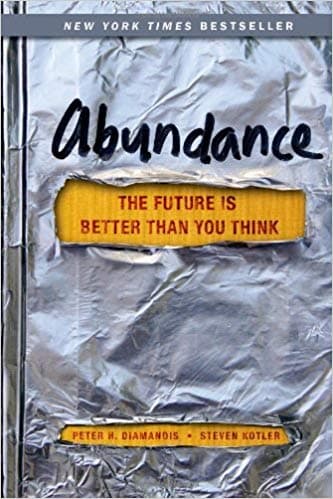Abundance by Peter Diamandis: Book Review, Summary, Lessons, Notes

Abundance Review
A nice catalog of reasons to be optimistic about the future, providing an antidote to mainstream news.
A little dry in places and is understandably one sided – highlighting only the positives about technology and none of the potential downsides (loss of privacy, addiction, EMFs, harm from blue light etc).
Worth skimming, especially for the great statistics and overview of the potential breakthroughs that could make a significant impact on our lives.
Worth noting that this book was published in 2012 over 7 years ago since I am writing this and whilst progress has been made on many of these areas there have been no significant breakthroughs.
Arguably we have only had smartphones and blockchain (not really covered in the book) as breakthroughs, and potential breakthroughs in the past 20 years.
Abundance Book Notes
5,000 times more solar energy than we use.
What is abundance?
- Clean water
- Healthy Food
- Durable Shelter
- Energy
- Education
- Information
- Communication
- Health
- Freedom
We seriously overestimate ourselves whilst we significantly underestimate the world at large.
A week of a newspaper contains more information than a 17th century person encountered in a lifetime.
“And the volume is growing exponentially. “From the very beginning of time until the year 2003,” says Google Executive Chairman Eric Schmidt, “humankind created five exabytes of digital information. An exabyte is one billion gigabytes—or a 1 with eighteen zeroes after it. Right now, in the year 2010, the human race is generating five exabytes of information every two days. By the year 2013, the number will be five exabytes produced every ten minutes … It’s no wonder we’re exhausted.”
We organize around groups of 150 – Dunbar’s Number
US military found it to be optimal size for a functional fighting unit
Cognitive biases and evolutionary psychology make us unable to be optimistic.
Cost of on hour of Light:
1750BC: 50 hours
1800: 6 hours
1880s: 15 mins
Today: 0.5 seconds
Exponential Technologies
Internet of Things
IPv6 has enough addresses for 50,000 trillion, trillion per person. Welcome to the internet of things.
Artificial Intelligence
Robotics
3D Printing
Medicine
Nanotech
Water
70% used for agriculture, 1 egg = 120 gallons.
97% salty, 2% polar ice.
Toilets that provide power from fecal mater and urine… Megajoule a day – power toilet and charge phone…
Food
- GE Crops
- Vertical Farming
- Cultured Meat
Forces of Abundance
- DIY Innovator
- Techo philanthropists
- Rising Billion – emerging market coming online
Energy
Bio fuels, batteries and intelligent systems
Education
Crowd source education. Using tablets as cheap tech. Most important factor is that it is self driven.
Health Care
Diagnosis via tech. Then using stem cells for treatment
Freedom to Abundance
Major Motivators:
- Curiosity
- Fear
- Wealth
- Significance
Incentivised competition to drive innovation.
Becoming comfortable with failure:
- Loss of reputation
- Loss of money
- Loss of time
<>>
5,000 times more solar energy than we use.
What is abundance?
- Clean water
- Healthy Food
- Durable Shelter
- Energy
- Education
- Information
- Communication
- Health
- Freedom
We seriously overestimate ourselves whilst we significantly underestimate the world at large.
A week of a newspaper contains more information than a 17th century person encountered in a lifetime.
“And the volume is growing exponentially. “From the very beginning of time until the year 2003,” says Google Executive Chairman Eric Schmidt, “humankind created five exabytes of digital information. An exabyte is one billion gigabytes—or a 1 with eighteen zeroes after it. Right now, in the year 2010, the human race is generating five exabytes of information every two days. By the year 2013, the number will be five exabytes produced every ten minutes … It’s no wonder we’re exhausted.”
We organize around groups of 150 – Dunbar’s Number
US military found it to be optimal size for a functional fighting unit
Cognitive biases and evolutionary psychology make us unable to be optimistic.
Cost of on hour of Light:
1750BC: 50 hours
1800: 6 hours
1880s: 15 mins
Today: 0.5 seconds
Exponential Technologies
Internet of Things
IPv6 has enough addresses for 50,000 trillion, trillion per person. Welcome to the internet of things.
Artificial Intelligence
Robotics
3D Printing
Medicine
Nanotech
Water
70% used for agriculture, 1 egg = 120 gallons.
97% salty, 2% polar ice.
Toilets that provide power from fecal mater and urine… Megajoule a day – power toilet and charge phone…
Food
- GE Crops
- Vertical Farming
- Cultured Meat
Forces of Abundance
- DIY Innovator
- Techo philanthropists
- Rising Billion – emerging market coming online
Energy
Bio fuels, batteries and intelligent systems
Education
Crowd source education. Using tablets as cheap tech. Most important factor is that it is self driven.
Health Care
Diagnosis via tech. Then using stem cells for treatment
Freedom to Abundance
Major Motivators:
- Curiosity
- Fear
- Wealth
- Significance
Incentivised competition to drive innovation.
Becoming comfortable with failure:
- Loss of reputation
- Loss of money
- Loss of time